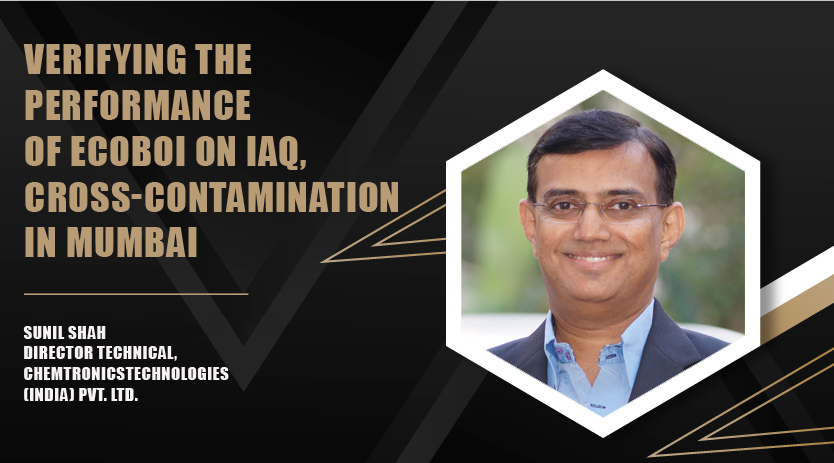The Electro-Chemical Oxidation & Bipolar Oxygen Ionization (ECOBOI) generator is capable of reducing & controlling all three physical, chemical and microbiological contaminations.
Objective The case study pertains to verifying the performance of ECOBOI on Indoor Air Quality (IAQ), cross contaminations & Surface BIOFILM for the safety & comfort of the office staff and environment. At the same time, harmful chemical residues were observed in the indoor environment, like TVOCs, Formaldehyde, CO2, and Ambient ozone.
Project: Corporate Office, Mumbai; Workspace Area: 2,250 sq. ft. Test Parameters: Surface: Total Bacterial Count (TBC) by Equinox Labs (NABL Accredited) Air: Total Bacterial Count (TBC). PM 2.5, PM 10, CO2, VOCs, Formaldehyde & Ambient Ozone. Proof of Concept (POC) by Team Chemtronics & Team Airfab.
Table experiment analysis summary Observations Microorganisms are the root cause of the cross contaminations.
Air and surface microbiological colonies
Initial Total Bacterial count in air & surface were 402 CFU/ m3 and 3,200 CFU/swab, respectively. After 30 days of operation of ECOBOI, the hidden bacteria & viruses under biofilm got exposed & the count increased to 460 CFU/m3 & 7,800 CFU/swab, respectively, of air & surface. The increase of TBC on the surface is due to oxidation of BIOFILMS & microorganisms exposed. With continual oxidation, the air count of total bacteria reduced to zero CFU/m3 & surface count reduced to 110 CFU/swab. The permissible count of TBC in the air is 500 CFU/m3 & on the surface is 200 CFU/swab. The root cause of crosscontamination is bacteria & viruses. The bacteria grow & multiply under the protective layers of BIOFILM. Refer to Annexure 01, which explains the life cycle of BIOFILM & can be seen how bacteria are protected under the BIOFILM even after chemical cleaning.
Particulate Matter: PM 2.5 & PM 10
Particulate matter in the ambient air consists of these colloidal suspended particles. PM 2.5 is smaller than or equal to 2.5 microns in size, and PM 10 is smaller than 10 microns. Initial observation of PM 2.5 & PM 10 were 143 ppm & 177 ppm respectively. These levels decreased to 0.43 ppm & 0.45 ppm, respectively, over 90 days, a significant reduction measuring 99.70 percent & 99.97 percent. Prescribed levels of PM 2.5 & PM 10 for good IAQ are 35 ppm & 150 ppm
This significant reduction is due to the combined effect of Bipolar Oxygen Ions & air filters. Control of PM 2.5 & PM 10 helps reduce allergies & surfaces where microorganisms like bacteria, viruses, mould and spores can stick.
Carbon Dioxide (CO2)
The primary source of indoor CO2 is the air exhaled by humans, which accounts for levels in the indoor atmosphere. Initial readings of CO2 level was 400 ppm & these levels gradually increased to 500 ppm in 30 days & 800 ppm in 90 days. This is due to the presence of staff, who are releasing CO2. The safe indoor permissible levels by OSHA are 5,000 ppm. Generally, good indoor CO2 levels should be below 1,200 to 1,500 ppm, depending on the activities and number of occupants per unit area. CO2 can not be treated, it has to be replaced with oxygen in the fresh air, and the equivalent quantity of CO2 should be exhausted. Oxidising chemical contaminations reduces the oxygen demand & more oxygen is left out, which is suitable for the occupants. Increased CO2 levels can reduce an individual’s concentration and drowsy dizziness, headaches, and visual & hearing dysfunction.
Total Volatile Organic Carbon (TVOC)
VOC is a cumulative value of all diversified organic volatile chemical fumes, pest control chemical fumes, housekeeping Chemical fumes, paint, varnish adhesives, synthetic interior materials, body odour, ointment, perfumes, and other personal care chemicals. The initial level of TVOC was 233 ppb. With the continuous operation of ECOBOI, TVOC levels are maintained as low as zero. Permissible levels for The indoor atmosphere is 500 ppb. There are estimated to be more than 5,000 known different kinds of VOCs. These VOCs can pose mild to severe health disorders and discomfort and irritation to the eyes, skin, throat & mucus membrane. These include allergies, vomiting, nausea, headache & many more. Sick Building Syndrome (SBS) is commonly known for VOCs adverse effects.
Formaldehyde
Formaldehyde, the colourless and irritating toxic gas, is easily soluble in water and methanol. Before the start of ECOBOI was 1.3 ppm, eventually becoming zero with control oxidation from ECOBOI. The permissible limits are 2.0 ppm. It has a disinfecting and antiseptic effect, which also has a stimulating effect on human mucosal tissue. When up to a specific concentration, It stimulates the eyes, nose and throat, coughing, fatigue, rash, and allergies will occur. The primary indoor sources of emissions are pressed wood products, adhesives, particle boards, mediumdensity fibreboard, and other finishing materials. In addition, burning cigarettes and other combustion sources, such as gas stoves, fire water heating devices, or certain consumer goods, such as paper products and cosmetics, will emit formaldehyde.
Ambient Ozone O3
Ozone has three molecules of oxygen; ozone is also called nature’s cleaning and disinfection agent. The greatest advantage of ozone is that its by-products are harmless to humans & the environment. Also, residual excess ozone naturally disintegrates into oxygen without any effort. But minimum prescribed levels of ozone must be maintained in an indoor environment where humans and pets are present. The safe permissible level is 0.1 ppm for 8 hours. The test readings show zero ppm presence of ozone in the indoor atmosphere, even with continuous operation of the ECOBOI generator.
Conclusion
With the POC done in a newly renovated corporate office workstation, it is observed that the ECOBOI generator installed in AHU provides a high degree of microbiological safety & thus prevents cross contaminations. Also, chemical pollutants like TVOCs, formaldehyde, & ambient ozone are reduced to practically zero levels.
Carbon Dioxide is also under healthy levels. The ECOBOI generator is capable of reducing & controlling all three physical, chemical and microbiological contaminants. As a result, the indoor CO2 levels are kept at a low level, and fresh mechanical air can be reduced by maybe around 5 percent, depending on application and no. of occupants per unit area.
Installing the prescribed model of ECOBOI generator in offices, schools, banks, hotels, and hospital premises will prove good because the density of people is high & there are strong possibilities of cross contaminations.
Cookie Consent
We use cookies to personalize your experience. By continuing to visit this website you agree to our Terms & Conditions, Privacy Policy and Cookie Policy.















